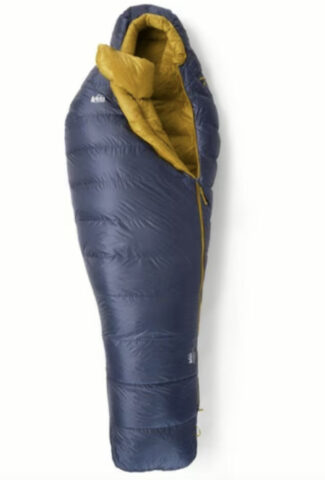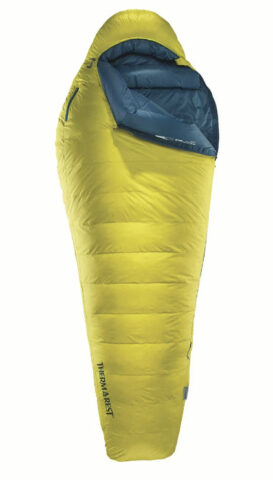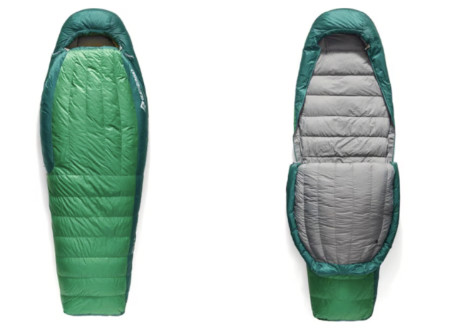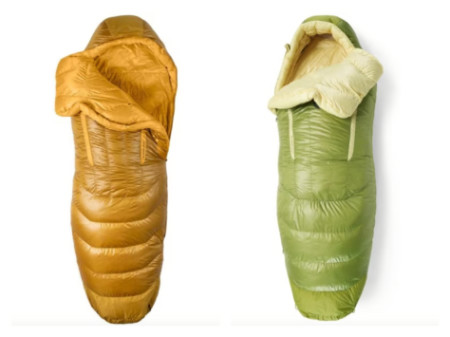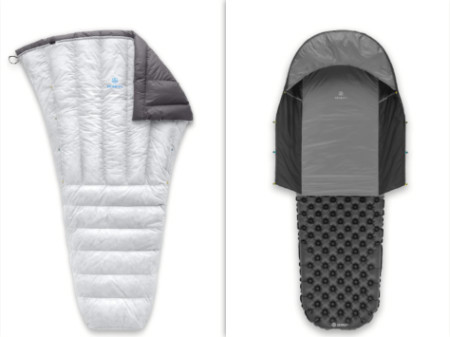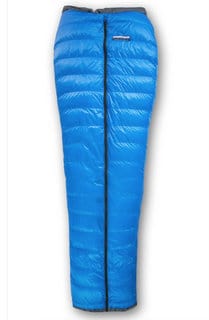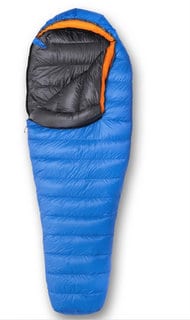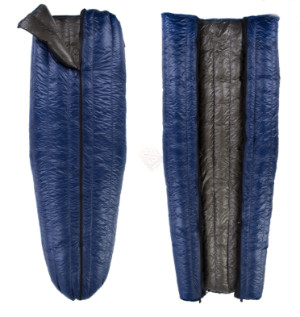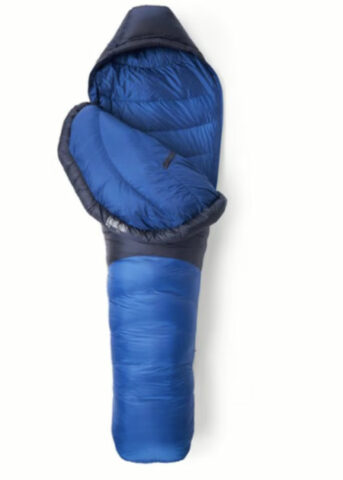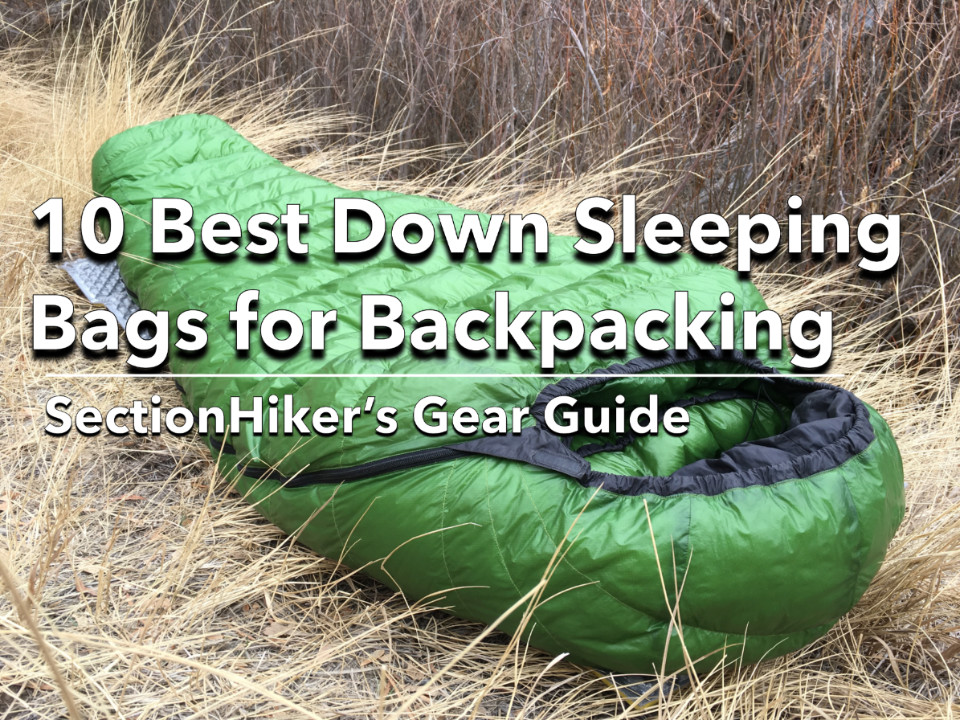
Down-insulated sleeping bags are still the most popular nighttime insulation option with backpackers because they’re highly compressible and warmer in cold, damp, or drafty weather, particularly in the spring and autumn when temperatures are close to freezing. While mummy bag designs still prevail, there’s a lot more variety in the types of sleeping bags that have become available in the past five years, including ones designed for side sleepers, women’s specific sleeping bags, and hoodless quilt-style sleeping bags.
When choosing a sleeping bag for backpacking, you want one that’s lightweight and highly compressible since you’re going to have to haul it in a backpack. Sleeping bags insulated with 800-950 goose or duck down are the best in terms of warmth by weight, but you’ll pay a premium at the top end. Lower fill power models are much more economical and only a few ounces heavier. If you want to stretch your dollar, look for bags with lower (as in colder) temperature ratings but lots of venting features to extend their temperature range into warmer weather.
Here are our top 10 down-insulated sleeping bag picks at various price points.
Be sure to read our recommendations below on how to choose the best sleeping bag for your needs.
1. REI Magma 15
The REI Magma 15 is a lightweight and compressible 850 fill-power down sleeping bag that’s loaded with features. It has a trapezoidal footbox with body-mapped baffles for maximum warmth retention while reducing weight. The bag has an insulated draft collar while the hood has a pillow pocket and two drawcords for flexible adjustment. A hybrid zipper path provides easy access along the shoulders and torso and the zipper is backed by an anti-snap strip for worry-free use. The REI Magma is also available in a 30-degree version.
Shop at REI
2. Western Mountaineering Versalite 10
The Western Mountaineering Versalite is a warm and spacious sleeping bag with plenty of interior room. It has continuous baffles so you can move the down where you need it most, on top on cold nights, and to the bottom of the bag on warm ones, thereby expanding its temperature range. A full-length zipper makes it easy to vent on warmer nights, while an insulated draft collar seals in the heat. A “flattish” mummy-style hood is also easier to use for side sleepers. The Versalite is available in three lengths: 5′ 6″, 6′ 0″, and 6′ 6″. Insulated with 850+ fill power goose down, it weighs in at just 32 ounces. It’s available in three lengths, making it ideal for backpackers who hike in cool mountain climates. Read the SectionHiker Versalite Review.
Shop at Backcountry
3. Therm-a-Rest Parsec 20
The Therm-a-Rest Parsec 20 is a very warm but lightweight 800 fill-power (hydrophobic Nikwax treated) down sleeping bag suitable for three-season use. It has bodymapped insulation with 60% of the down positioned over the chest and 40% on the bottom to reduce weight and provide enhanced warmth when used with an appropriate sleeping pad. The Parsec 20 has a draft collar and zipper draft tube to hold in your body heat with a two-way zipper so you can vent the bag if you feel too warm. Special sleeping pad straps help prevent you from rolling off your pad at night, while exterior loops let you layer compatible quilts or technical blankets on top to boost the Parsec’s temperature rating. Read the SectionHiker Parsec review.
Shop at REI
4. Sea-to-Summit Ascent 15 Sleeping Bag
The Sea-to-Summit Ascent 15 is a 750 fill-power water-resistant goose down sleeping bag with two side zippers and a foot box zipper that can be opened in warmer weather, giving the sleeping bag a wide temperature range. Box baffle construction throughout with vertical baffles in the torso minimize down shift and maximize warmth retention. Thermally efficient, it has a relaxed mummy fit with room in the hood to fit a pillow. In colder temperatures, you can cinch down the technical hood and zip up the draft-tube-protected zippers for a cozy nights sleep. A women’s model is also available. Read the SectionHiker Ascent Review.
5. NEMO Disco 15 (men’s and women’s)
The NEMO Disco 15 is a spoon-shaped sleeping bag designed for side sleepers that adds room at the elbows and knees but is shaped to save weight. It is insulated with 650 fill-power hydrophobic PFC-free RSD-certified down and comes with a waterproof/breathable hood and footbox to prevent it from getting wet if your tent develops internal condensation. This bag comes with a full-length double-sided zipper, a pillow pocket, a huge draft collar to seal in your torso heat, and thermo-gills to help you vent excess heat, extending the range of the bag for warmer weather. The Disco weighs 2 lbs 11 oz and fits men up to 6′ tall. A women’s Disco 15 is also available.
6. Zenbivy Ultralight Bed
The Zenbivy Ultralight Bed is an integrated sleep system that provides the warmth of a sleeping bag in a fully integrated quilt-based sleep system. While the individual components can still be purchased separately, the degree of integration between the components including a 900-fill power down quilt, an inflatable sleeping pad, a sheet, and an optional hood provides an unparalleled and draft-free sleep experience. The Ultralight Bed is available in multiple sizes and at multiple temperature ratings. Everyone I know who’s bought a Zenbivy sleep system, including very experienced backpackers, raves about it! See our review of the Zenbivy Ultralight Bed.
7. Feathered Friends Flicker UL 20
The Feathered Friends Flicker UL 20 is a highly versatile hoodless sleeping bag that’s ideal for side sleepers who find a mummy bag claustrophobic. In cooler weather, the Flicker functions as a full center-zip mummy sleeping bag with a heat-saving down-filled draft collar that drapes around your neck and over your shoulders to seal in heat. It has a drawstring foot box that can be cinched tight on cooler nights or opened up to vent the bag if you’re too warm. Unzipped, it can be flipped over on warmer nights and used like a quilt or a blanket since the foot box opens completely. Insulated with 950+ fill power down, the 20ºF Flicker has continuous baffles that let you move the down insulation to where you need it. Weighing 26 oz, it’s perfect for cool summer nights in alpine terrain and thru-hikes. Read the SectionHiker Flicker Review.
8. Feathered Friends Egret UL 20 (women’s)
The Feathered Friends Egret UL 20 is a top-shelf technical sleeping bag tailored for the female form that features extra fill in the foot box and around the chest. It also provides more room in the elbows including space to draw your knees up in the bag if you like to sleep that way. The contoured hood opens wide in warmer weather, making it easy for side sleepers to use, while a two-way zipper makes the bag easy to vent. The Egret has a draft collar to help seal in the heat around your shoulders, with a trapezoidal foot box that allows your feet to fall in a natural pose without compressing the sides. Available in two lengths: 5′ 3″ and 5′ 9″, the Egret UL 20 is insulated with 950+ fill power goose down and weighs just 27 oz.
9. Enlightened Equipment Convert
The Enlightened Equipment Convert is a hoodless, quilt-style sleeping bag with a full-length zipper and drawstring foot box that allows it to be completely closed like a hoodless sleeping bag, completely open like a down comforter, or partially zipped up like a backpacking quilt. It’s insulated with RSD-certified 850 fill power down and has a snap and drawcord neck closure that lets you fine-tune draft control. The lack of a hood makes it a great choice for side sleepers while the full-length zipper and foot box gives it more temperature flexibility than a quilt or sleeping bag alone. When ordering you can specify the temperature rating or width you’d like. For spring and autumn weather, we’d recommend a 10 or 20 degree bag, since it’s so easy to vent for warmer weather. For women, we suggest adding another 10 degrees’ worth of insulation. Read the SectionHiker Review.
10. Marmot Helium 15
The Marmot Helium 15 is a mummy-style sleeping bag insulated with 800 fill power goose down that’s been treated with Down Defender to make it more weather resistant and dry faster. The Helium, which Marmot refers to as a “gas” bag (get it?), has smooth, curved baffles that minimize down shift and help eliminate cold spots. It has an anti-snag slider on the main zipper and a fold-down second zipper that provides added ventilation and easy access in and out of sleeping bag. An anatomically designed footbox with wrap-around construction, zipper draft tubes along the sides, and a multi-baffle hood with draft collar increase warmth retention. Finally, the bag’s premium Pertex Quantum shell fabric provides a lightweight but rip-resistant finish that keeps the Helium’s weight close to two pounds.
Shop at REI
Sleeping Bag Purchase Criteria
Here is a list of the most important factor to consider when purchasing a sleeping bag for backpacking, so it fits your needs and preferences.
TEMPERATURE RATINGS: The introduction of standardized sleeping bag temperature ratings by the outdoor industry substantially improved their reliability. Bags tested with the European Norm (EN) 13537 get two ratings: a Comfort rating and Lower limit rating. The Comfort rating is the lowest temperature at which the bag will keep the average woman (or “cold sleeper”) comfortable, and the Lower Limit rating is the lowest temperature at which the bag will keep an average man (or “warm sleeper”) comfortable. The difference in the Comfort and Lower Limit ratings is usually about 10 degrees since women feel colder than men when sleeping. If you’re a woman and decide to buy a men’s or unisex bag, get one that’s 10 degrees warmer than you need so you’re comfortable at night
INSULATION and COMPRESSIBILITY: High-quality goose and duck down with fill powers of 800, 850, 900, and 950 provide excellent insulation by weight and are widely preferred by backpackers and base campers because they’re so lightweight. Some manufacturers only offer down that’s been treated with a water-repellent coating, while others prefer to offer it unadulterated. Down is naturally water-resistant so the jury is still out on whether “treated” down makes a difference in the long-term since it’s easy to keep your sleeping bag dry with a little care.
SIZING: The fit of a sleeping bag is usually measured in terms of length and girth. Girth measures the maximum internal circumference of the bag, usually at the shoulders, hips, and feet. Measure yourself at these points and compare them to the girth to see if the bag will fit tightly or loosely. People with bigger shoulders or sides sleepers tend to feel more comfortable in bags with higher shoulder girths, while women typically need a shorter length bag and a smaller shoulder girth because they have narrower shoulders than men. It’s important to get a bag that minimizes the amount of unoccupied interior space relative to your measurements, so your body has less air to heat up to stay warm. If a bag is too large, it will feel colder than one that fits closely, since your body needs to work harder to fill the extra space with hot air.
WEIGHT: While gear weight is important, be careful not to sacrifice your comfort by selecting a sleeping bag that won’t keep you warm or dry in the conditions you need it to. When choosing between bags with different outer shell fabrics, consider their breathability, so they will vent perspiration that can degrade your insulation, and whether they have a DWR coating, which can be important if the foot of your quilt gets wet regularly.
FEATURES: Most sleeping bags are pretty similar when it comes right down to it, but there are some features that set premium sleeping bags better than nonpremium bags. These include draft collars, continuous baffles, very high fill-power goose down, non-snagging zippers, draft tubes positioned behind zippers to seal out the cold, ventable foot boxes, and full-length zippers that help extend the range of a bag in warmer weather.
Check Out All of SectionHiker’s Gear Guides!
SectionHiker is reader-supported. We only make money if you purchase a product through our affiliate links. Help us continue to test and write unsponsored and independent gear reviews, beginner FAQs, and free hiking guides.

